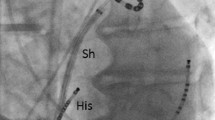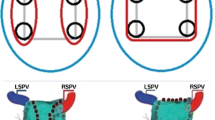Abstract
Purpose
Remote magnetic navigation (RMN) is utilized for catheter guidance during pulmonary vein ablation (PVA). We aimed to determine whether the additional use of a circular mapping catheter (CMC) influences efficacy and outcome of RMN-guided PVA.
Methods
A total of 80 consecutive subjects (65 % male, age 62 ± 9 years) underwent circumferential PVA with a 3D mapping system and an RMN-guided irrigated catheter. Procedural endpoint was complete PV isolation (PVI), total radiofrequency (RF) time >60 min, or procedure duration >5 h. PVI was defined as an entrance and/or exit block, diagnosed with a CMC within the PV ostium or by pacing via the roving RMN-guided catheter (single-catheter technique). Prolonged Holter monitoring after 3 and 6 months was used to detect atrial tachyarrhythmia (AT/AF) recurrences.
Results
Complete PVI was achieved in 56 % (45/80) of all subjects (isolated PVs per patient, 3.1 ± 1.2; RF time, 56.3 ± 17.2 min; procedure duration, 3.8 ± 0.8 h). Prospective validation of the single-catheter technique for diagnosing PVI demonstrated high concordance (94 %) with blinded CMC results. CMC use in first-time PVA was associated with similar total RF and procedure times but higher PV isolation rate. Upon multivariate analysis, CMC use, female gender, left PV, smaller PV ostium and repeat PVA predicted PVI during RMN-guided ablation. Persistent AF and mitral regurgitation at baseline and the number of non-isolated PVs predicted AT/AF recurrence during follow-up.
Conclusions
Concomitant CMC use for first-time, RMN-guided PVA is associated with similar procedure duration but higher PV isolation rates as compared to a single-catheter approach. Since the number of isolated PVs predicts freedom from AT/AF, CMC utilization appears advisable for first-time, RMN-guided PVA.





Similar content being viewed by others
Abbreviations
- AF:
-
Atrial fibrillation
- AT:
-
Atrial tachycardia
- BMI:
-
Body mass index
- CMC:
-
Circular mapping catheter
- CT:
-
Computer tomography
- LA:
-
Left atrial
- PV:
-
Pulmonary vein
- RF:
-
Radiofrequency
- RMN:
-
Remote magnetic navigation
References
Calkins, H., Kuck, K. H., Cappato, R., Brugada, J., Camm, A. J., Chen, S. A., et al. (2012). 2012 HRS/EHRA/ECAS expert consensus statement on catheter and surgical ablation of atrial fibrillation: recommendations for patient selection, procedural techniques, patient management and follow-up, definitions, endpoints, and research trial design: a report of the Heart Rhythm Society (HRS) Task Force on Catheter and Surgical Ablation of Atrial Fibrillation. Developed in partnership with the European Heart Rhythm Association (EHRA), a registered branch of the European Society of Cardiology (ESC) and the European Cardiac Arrhythmia Society (ECAS); and in collaboration with the American College of Cardiology (ACC), American Heart Association (AHA), the Asia Pacific Heart Rhythm Society (APHRS), and the Society of Thoracic Surgeons (STS). Endorsed by the governing bodies of the American College of Cardiology Foundation, the American Heart Association, the European Cardiac Arrhythmia Society, the European Heart Rhythm Association, the Society of Thoracic Surgeons, the Asia Pacific Heart Rhythm Society, and the Heart Rhythm Society. Journal of Interventional Cardiac Electrophysiology, 33, 171–257.
Camm, A. J., Lip, G. Y., De Caterina, R., Savelieva, I., Atar, D., Hohnloser, S. H., et al. (2012). 2012 focused update of the ESC Guidelines for the management of atrial fibrillation: an update of the 2010 ESC Guidelines for the management of atrial fibrillation—developed with the special contribution of the European Heart Rhythm Association. Europace, 14(10), 1385–1413.
Bradfield, J., Tung, R., Mandapati, R., Boyle, N. G., & Shivkumar, K. (2012). Catheter ablation utilizing remote magnetic navigation: a review of applications and outcomes. Pacing and Clinical Electrophysiology, 35(8), 1021–1034.
Arya, A., Zaker-Shahrak, R., Sommer, P., Bollmann, A., Wetzel, U., Gaspar, T., et al. (2011). Catheter ablation of atrial fibrillation using remote magnetic catheter navigation: a case–control study. Europace, 13(1), 45–50.
Luthje, L., Vollmann, D., Seegers, J., Dorenkamp, M., Sohns, C., Hasenfuss, G., et al. (2011). Remote magnetic versus manual catheter navigation for circumferential pulmonary vein ablation in patients with atrial fibrillation. Clinical Research in Cardiology, 100(11), 1003–1011.
Miyazaki, S., Shah, A. J., Xhaet, O., Derval, N., Matsuo, S., Wright, M., et al. (2010). Remote magnetic navigation with irrigated tip catheter for ablation of paroxysmal atrial fibrillation. Circulation. Arrhythmia and Electrophysiology, 3(6), 585–589.
Chun, K. R., Wissner, E., Koektuerk, B., Konstantinidou, M., Schmidt, B., Zerm, T., et al. (2010). Remote-controlled magnetic pulmonary vein isolation using a new irrigated-tip catheter in patients with atrial fibrillation. Circulation. Arrhythmia and Electrophysiology, 3(5), 458–464.
Bauernfeind, T., Akca, F., Schwagten, B., de Groot, N., Van Belle, Y., Valk, S., et al. (2011). The magnetic navigation system allows safety and high efficacy for ablation of arrhythmias. Europace, 13(7), 1015–1021.
Furnkranz, A., Julian, J. K., Schmidt, B., Wohlmuth, P., Tilz, R., Kuck, K. H., et al. (2011). Ipsilateral pulmonary vein isolation performed by a single continuous circular lesion: role of pulmonary vein mapping during ablation. Europace, 13(7), 935–941.
Augello, G., Vicedomini, G., Saviano, M., Crisa, S., Mazzone, P., Ornago, O., et al. (2009). Pulmonary vein isolation after circumferential pulmonary vein ablation: comparison between Lasso and three-dimensional electroanatomical assessment of complete electrical disconnection. Heart Rhythm, 6(12), 1706–1713.
Dong, J., Liu, X., Long, D., Yu, R., Tang, R., Lu, F., et al. (2009). Single-catheter technique for pulmonary vein antrum isolation: is it sufficient to identify and close the residual gaps without a circular mapping catheter? Journal of Cardiovascular Electrophysiology, 20(3), 273–279.
Eitel, C., Hindricks, G., Sommer, P., Gaspar, T., Kircher, S., Wetzel, U., et al. (2010). Circumferential pulmonary vein isolation and linear left atrial ablation as a single-catheter technique to achieve bidirectional conduction block: the pace-and-ablate approach. Heart Rhythm, 7(2), 157–164.
Pappone, C., Vicedomini, G., Manguso, F., Gugliotta, F., Mazzone, P., Gulletta, S., et al. (2006). Robotic magnetic navigation for atrial fibrillation ablation. Journal of the American College of Cardiology, 47(7), 1390–1400.
Vollmann, D., Luthje, L., Seegers, J., Hasenfuss, G., & Zabel, M. (2009). Remote magnetic catheter navigation for cavotricuspid isthmus ablation in patients with common-type atrial flutter. Circulation. Arrhythmia and Electrophysiology, 2(6), 603–610.
Shah, D. (2009). Electrophysiological evaluation of pulmonary vein isolation. Europace, 11(11), 1423–1433.
Sohns, C., Sohns, J. M., Vollmann, D., Luthje, L., Bergau, L., Dorenkamp, M., et al. (2013). Left atrial volumetry from routine diagnostic work up prior to pulmonary vein ablation is a good predictor of freedom from atrial fibrillation. European Heart Journal-Cardiovascascular Imaging, 14(7), 684–691.
Pinheiro, J. C., & Bates, D. M. (2000). In J. Chambers, W. Eddy, W. Härdle, S. Sheather, & L. Tierney (Eds.), Mixed-effects models in S and S-PLUS. 2nd edition 2009 ed. New York: Springer.
Kass, R. E., & Raftery, A. E. (1995). Bayes factors. Journal of the American Statistical Association, 90(430), 773–795.
Steven, D., Reddy, V. Y., Inada, K., Roberts-Thomson, K. C., Seiler, J., Stevenson, W. G., et al. (2010). Loss of pace capture on the ablation line: a new marker for complete radiofrequency lesions to achieve pulmonary vein isolation. Heart Rhythm, 7(3), 323–330.
Duytschaever, M., De Meyer, G., Acena, M., El-Haddad, M., De Greef, Y., Van Heuverswyn, F., et al. (2013). Lessons from dissociated pulmonary vein potentials: entry block implies exit block. Europace, 15(6), 805–812.
Vijayaraman, P., Dandamudi, G., Naperkowski, A., Oren, J., Storm, R., & Ellenbogen, K. A. (2012). Assessment of exit block following pulmonary vein isolation: far-field capture masquerading as entrance without exit block. Heart Rhythm, 9(10), 1653–1659.
Di Biase, L., Burkhardt, J. D., Lakkireddy, D., Sanchez, J., Pillarisetti, J., Horton, R., et al. (2010). Remote magnetic navigation for ablation of atrial fibrillation with the open irrigation ablation catheter: acute endpoint with circumferential ablation versus circular mapping guided ablation. Journal of the American College of Cardiology, 9, 55(10).
Solheim, E., Off, M. K., Hoff, P. I., De Bortoli, A., Schuster, P., Ohm, O. J., et al. (2011). Remote magnetic versus manual catheters: evaluation of ablation effect in atrial fibrillation by myocardial marker levels. Journal of Interventional Cardiac Electrophysiology, 32(1), 37–43.
Tamborero, D., Mont, L., Berruezo, A., Guasch, E., Rios, J., Nadal, M., et al. (2010). Circumferential pulmonary vein ablation: does use of a circular mapping catheter improve results? A prospective randomized study. Heart Rhythm, 7(5), 612–618.
Nolker, G., Gutleben, K. J., Muntean, B., Vogt, J., Horstkotte, D., Dabiri Abkenari, L., et al. (2012). Novel robotic catheter manipulation system integrated with remote magnetic navigation for fully remote ablation of atrial tachyarrhythmias: a two-centre evaluation. Europace, 14(12), 1715–1718.
Lemola, K., Oral, H., Chugh, A., Hall, B., Cheung, P., Han, J., et al. (2005). Pulmonary vein isolation as an end point for left atrial circumferential ablation of atrial fibrillation. Journal of the American College of Cardiology, 46(6), 1060–1066.
Zhao, X., Zhang, J., Hu, J., Liao, D., Zhu, Y., Mei, X., et al. (2013). Pulmonary antrum radial-linear ablation for paroxysmal atrial fibrillation: interim analysis of a multicenter trial. Circulation. Arrhythmia and Electrophysiology, 6(2), 310–317.
Pratola, C., Baldo, E., Notarstefano, P., Toselli, T., & Ferrari, R. (2008). Radiofrequency ablation of atrial fibrillation: is the persistence of all intraprocedural targets necessary for long-term maintenance of sinus rhythm? Circulation, 117(2), 136–143.
Disclosures
D.V., M.Z.: Research funding from Stereotaxis; L.L.: Lecture fee from Stereotaxis; D.V., M.Z., J.S.: Travel grant from Biosense Webster
Author information
Authors and Affiliations
Corresponding author
Rights and permissions
About this article
Cite this article
Vollmann, D., Lüthje, L., Seegers, J. et al. Remote magnetic navigation for circumferential pulmonary vein ablation: single-catheter technique or additional use of a circular mapping catheter?. J Interv Card Electrophysiol 41, 65–73 (2014). https://doi.org/10.1007/s10840-014-9912-0
Received:
Accepted:
Published:
Issue Date:
DOI: https://doi.org/10.1007/s10840-014-9912-0




